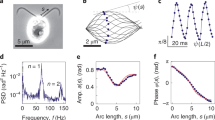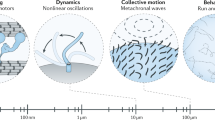Abstract
We document a novel approach for quantitative assessment of ciliary activity, exemplified in rapid three-dimensional cyclic motion of the frontal cirri of Stylonychia. Cells held under voltage-clamp control are stimulated by step pulses to elicit reproducible hyperpolarization- or depolarization-induced ciliary motor responses. High-speed video recording at 200 fields per second is used for imaging ciliary organelles of the same cell in two perspectives: the axial view and, following cell rotation by 90°, the lateral view. From video sequences of typically 1 s, the contours of the cirral images are determined and digitized. Computer programs are established to (1) reduce an observed image to a “ciliary axis”, (2) sort series of axes by template to generate an averaged ciliary cycle in 2D-projection, and (3) to associate the generalized axial and lateral 2D-images for generation of a sequence of three-dimensional images, which quantitatively represent the cycle in space and time. The method allows us to produce pre-determined perspectives of images selected from the ciliary cycle, and to generate stereo views for graphical representation of ciliary motion. The approach includes a potential for extraction of the complete microtubular sliding program of a cilium under reproducible electric stimulation of the ciliary membrane.
Similar content being viewed by others
References
Blum, J. J., Hines, M.: Biophysics of flagellar motility. Q. Rev. Biophys. 12, 103–180 (1979)
Brokaw, C. J., Josslin, R.: Maintenance of constant wave parameters by sperm flagella at reduced frequencies of beat. J. Exp. Biol. 59, 617–628 (1973)
De Peyer, J. E., Machemer, H.: Membrane excitability in Stylonychia: Properties of the two-peak regenerative Ca-response. J. Comp. Physiol. 121, 15–32 (1977)
De Peyer, J. E., Machemer, H.: Electromechanical coupling in cila I. Effects of depolarizing voltage steps. Cell Motility 2, 483–496 (1982)
Eshel, D., Brokaw, C. J.: New evidence for a “biased baseline” mechanism for calcium-regulated asymmetry of flagellar bending. Cell Motility Cytoskel. 7, 160–168 (1987)
Frankel, J.: Pattern formation in ciliated Protozoa. In: Malacinski, G. M., Bryant, S. V. (eds.) Pattern formation — a primer in developmental biology, pp. 163–196. Macmillan Publishing Company 1984
Hennessey, T. M., Kung, C.: Slow inactivation of the calcium current of Paramecium is dependent on voltage and not internal calcium. J. Physiol. 365, 165–179 (1985)
Hiramoto, Y., Baba, S. A.: A quantitative analysis of flagellar movement in echinoderm spermatozoa. J. Exp. Biol. 76, 85–104 (1987)
Inoué, S.: Video microscopy, pp. 1–584. New York London: Plenum Press 1986
Machemer, H.: Properties of polarized ciliary beat in Paramecium. Acta Protozool. 11, 295–300 (1972a)
Machemer, H.: Ciliary activity and the origin of metachrony in Paramecium: Effects of increased viscosity. J. Exp. Biol. 57, 239–259 (1972b)
Machemer, H.: Electromotor coupling in cilia. In: Lüttgau, H. C. (eded.) Membrane control of cellular activity. Fortschr. Zool. 33, 205–250 (1986)
Machemer, H.: Cilia in cell motility: membrane-controlled rotary engines. Zool. Science 7 (Suppl.), 23–34 (1990)
Machemer, H., Deitmer, J. W.: From structure to behaviour: Stylonychia as a model system for cellular physiology. In: Corliss, J. O., Patterson, D. J. (eds.) Progress in Protistology, vol. 2, pp. 213–330. Bristol: Biopress Ltd. 1987
Machemer, H., Sugino, K.: Parameters of the ciliary cycle under membrane voltage control. Cell Motility Cytoskel. 6, 89–95 (1986)
Sugino, K., Machemer, H.: Axial-view recording: An approach to assess the third dimension of the ciliary cycle. J. Theor. Biol. 125, 67–82 (1987)
Sugino, K., Machemer, H.: The ciliary cycle during hyperpolarization-induced activity: an analysis of axonemal functional parameters. Cell Motility Cytoskel. 11, 275–290 (1988)
Sugino, K., Machemer, H.: Depolarization-controlled parameters of the ciliary cycle and axonemal function. Cell Motility Cytoskel. 16, 251–265 (1990)
Sugino, K., Naitoh Y.: Simulated cross-bridge patterns corresponding to ciliary beating in Paramecium. Nature 295, 609–611 (1982)
Tamm, S. L., Sonneborn, T. M., Dippell, R. V.: The role of cortical orientation in the control of the direction of ciliary beat in Paramecium. J. Cell Biol. 64, 98–112 (1975)
Witman, G. B.: Introduction to cilia and flagella. In: Bloodgood, R. A. (ed.) Ciliary and flagellar membranes, pp. 1–30. Plenum Publishing Corporation 1990
Author information
Authors and Affiliations
Rights and permissions
About this article
Cite this article
Mogami, Y., Pernberg, J. & Machemer, H. Ciliary beating in three dimensions: Steps of a quantitative description. J. Math. Biol. 30, 215–249 (1992). https://doi.org/10.1007/BF00176150
Received:
Revised:
Issue Date:
DOI: https://doi.org/10.1007/BF00176150




